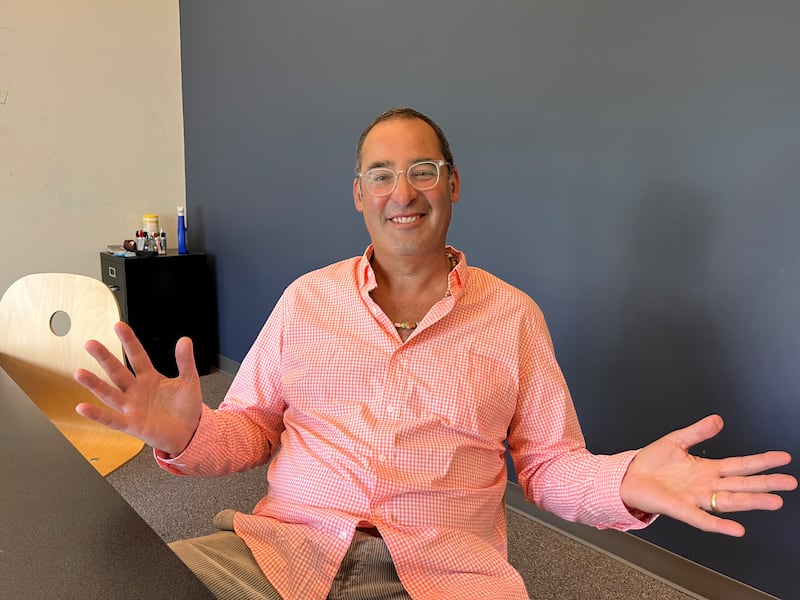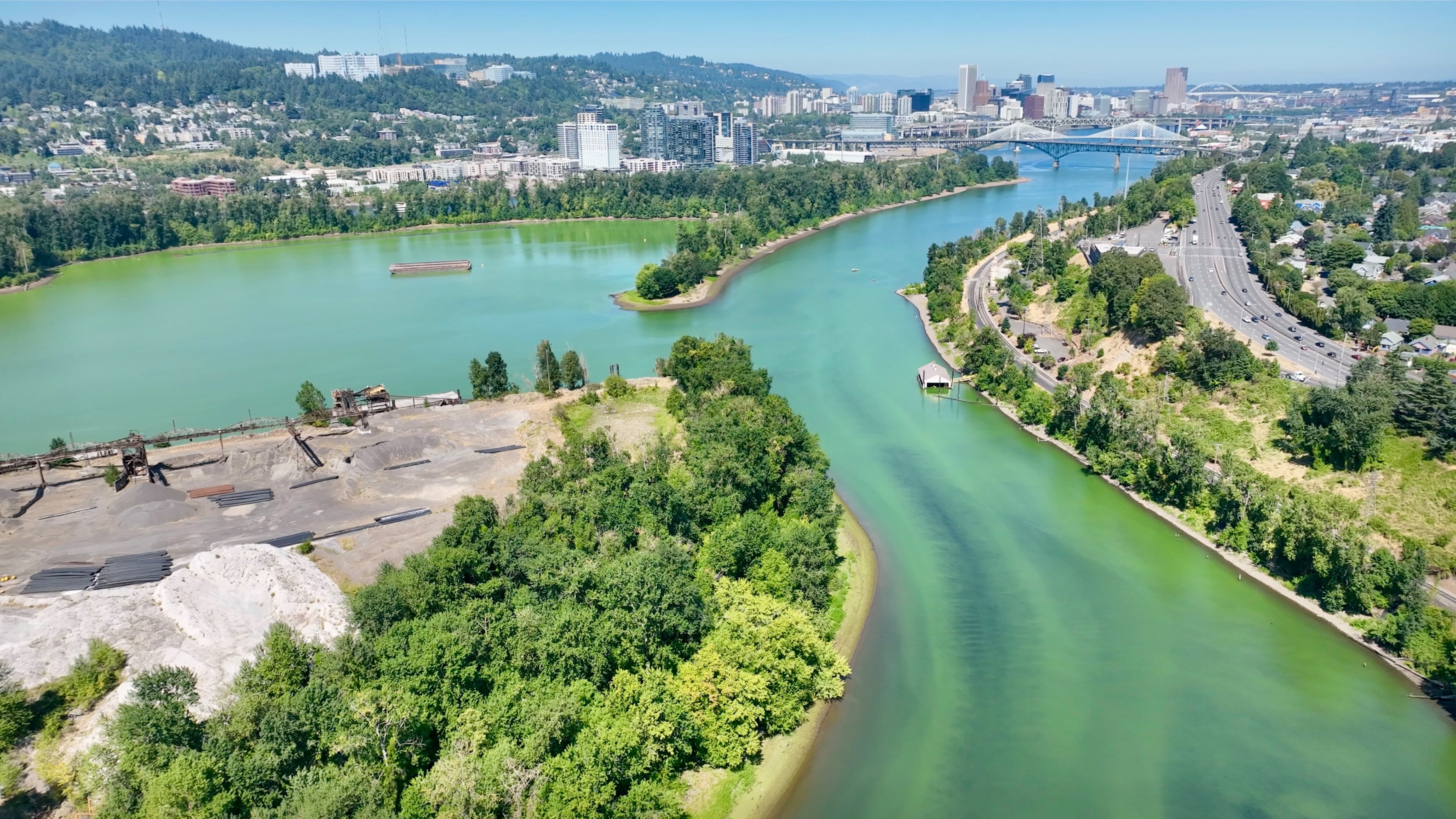Last week, as scorching temperatures sent Portlanders searching for a swimming hole, the Willamette River turned a shade of neon green usually associated with the trim on Seattle Seahawks jerseys. That color was a warning: It signaled a toxic algae bloom, some of which started in Ross Island Lagoon. The flare-up of cyanobacteria, or blue-green algae, made a dip in the river hazardous for people and potentially deadly for dogs.
For Willie Levenson, the algae bloom was especially wrenching. But it wasn’t surprising. The problem has been his priority for years.
Levenson, 53, is probably the person most associated with swimming in the Willamette. As Ringleader of the nonprofit Human Access Project, he launched and oversaw the Big Float, an annual summer tubing event intended to build Portland’s trust that it was safe to go back in the water.
But Levenson declared the 2022 Big Float would be his last. Few people knew it at the time, but he’d decided to turn his energy to finding a way to reduce toxic algae blooms in Ross Island Lagoon.
“Going around on tours on the Willamette this past week, seeing it just looking like a ghost town, it was eerie and sad,” Levenson tells WW. “That’s not the city I want to live in. I don’t want to live in a city where I’m afraid to bring my dog to the river.”
The lagoon, located at mile 15.4 of the river, was carved over decades by Ross Island Sand & Gravel, a subsidiary of the business empire overseen by textile and newspaper magnate Robert Pamplin Jr. (“Trader Bob,” WW, Feb. 23, 2022). Because the longtime gravel pit has just one outlet to the river, water that enters the lagoon stagnates—and when the temperature rises, it’s an incubator for algae. “The Ross Island Lagoon is a pond inside of a river,” Levenson says. “It’s a harmful algae bloom factory.”
A representative of R.B. Pamplin Corp. did not respond to a request for comment on this story.
When an algae bloom in July 2015 threatened to cancel the Big Float, Levenson took notice. In 2017, he started working with Dr. Desirée Tullos, a professor of water resources engineering at Oregon State University, on a plan to fix the lagoon. The solution they propose is neither novel nor difficult to grasp: Ross Island Lagoon needs a flushing channel, so river water flowing in can also flow out.
This week, Levenson dropped by WW’s offices to talk about why executing that idea isn’t as easy as it sounds, how algae became the biggest barrier to public use of the Willamette, and what responsibility Pamplin has to the river. The interview has been edited for clarity and brevity.

WW: How common are these algae blooms?
Willie Levenson: Every year there’s an algae bloom in the Ross Island Lagoon. It’s just a matter of whether it gets exacerbated enough so that it leaves the lagoon. It’s probably been happening for the last 15 years or so. It just came to our attention in 2015.
How did this get on your radar?
I probably never would’ve started Human Access Project if I knew I was going to become an algae warrior. In 2015, we’re getting ready to do the Big Float. The lagoon turns green. It’s starting to migrate through the Holgate Channel. I get contacted by the state Department of Environmental Quality and Oregon Health Authority. You can get a sample of river water and ship it to the Midwest and they’ll tell you whether it’s toxic or not. We paid for it to be done, shipped to the Midwest, turned out was negative, and fortunately we were able to go on with the Big Float.
Are these blooms the reason you’ve transitioned from the Big Float into this work?
Correct. In 2018, I started having this existential problem with doing the Big Float. I reached out to my board and told them: “We’re turning into a harmful algae bloom mitigation organization.” Our mission is transforming Portland’s relationship with the Willamette River. If we don’t solve the harmful algae bloom problem, all of this work that we’ve done is frivolous. It’s an environmental issue, but it’s also a psychological issue.
Because if you hear that the Willamette River is filled with toxic blue-green algae—
You lose hope. It doesn’t matter what cause you’re working on, if you lose the hope of the public, the battle’s over. I think of the broken window theory. You throw the first baseball through the window, you don’t fix it. And then another one goes through the window and it’s covered with graffiti. As climate change happens, and a lot of this stuff makes you want to curl into a ball and cry, all of a sudden the river turns green? We will lose the hope of the public.
But this is absolutely a solvable problem. And I’m hopeful that when we do solve it, it’ll give people hope that, as we address future climate change surprises, that humans may have some capacity to solve these problems.
What’s the best solution?
The best solution appears to be putting a channel through the lagoon. So, in 1926, Ross Island was four separate islands with a flow in between. The U.S. Army Corps of Engineers put in an earthen dam connecting the islands in 1926, effectively creating a lagoon, cutting off the water circulation. It seems fairly obvious, but we’re just basically looking to reintroduce circulation between the islands.
How much would that cost?
I have no clue. We’re going to find out. That’s what 30% cost engineering is going to do.
Part of me thinks a decent-sized explosive could take care of the problem fairly easily.
I’ve heard people say that. Part of the complication is that Ross Island accepted materials from Portland Harbor that turned out to be contaminated. There’s two buried CAD cells, which is basically buried toxic stuff inside. The good news is, there is room between the cells to put this channel, but it does complicate things.
How open has Ross Island Sand & Gravel been to your research?
The company has been very supportive. But what I would say is that Ross Island Sand & Gravel is owned by Dr. Robert Pamplin. Ross Island Sand & Gravel shaped the ecology of the lagoon. Dr. Pamplin’s legacy will either be the person who saved the ecology of the lower Willamette, or the person who destroyed it.
Our team would love to be able to visit with Dr. Pamplin to this point. We’ve had trouble meeting with him.
Are you done with the Big Float? Will we ever see it again?
In terms of my own personal capacity, I just realized we’ve got bigger fish to fry. But we are looking to bring it back next year. We’re exploring it with another nonprofit to take it over, whom it’s too early to name. I think there’s a very good chance it’s going to come back next year.
The first year that we did the Big Float, 99% of Portland thought I was nuts. The idea of swimming the river was crazy. We’ve normalized it. The Big Float, to me, was a movement disguised as a party. And 13 years later, what’s cool is that there’s clearly a stronger relationship, so people are feeling pain from this loss of the river. My guide star with Human Access Project is Jacques Cousteau’s quote: “People protect what they love.” This sense of loss is that feeling of love for this river.
